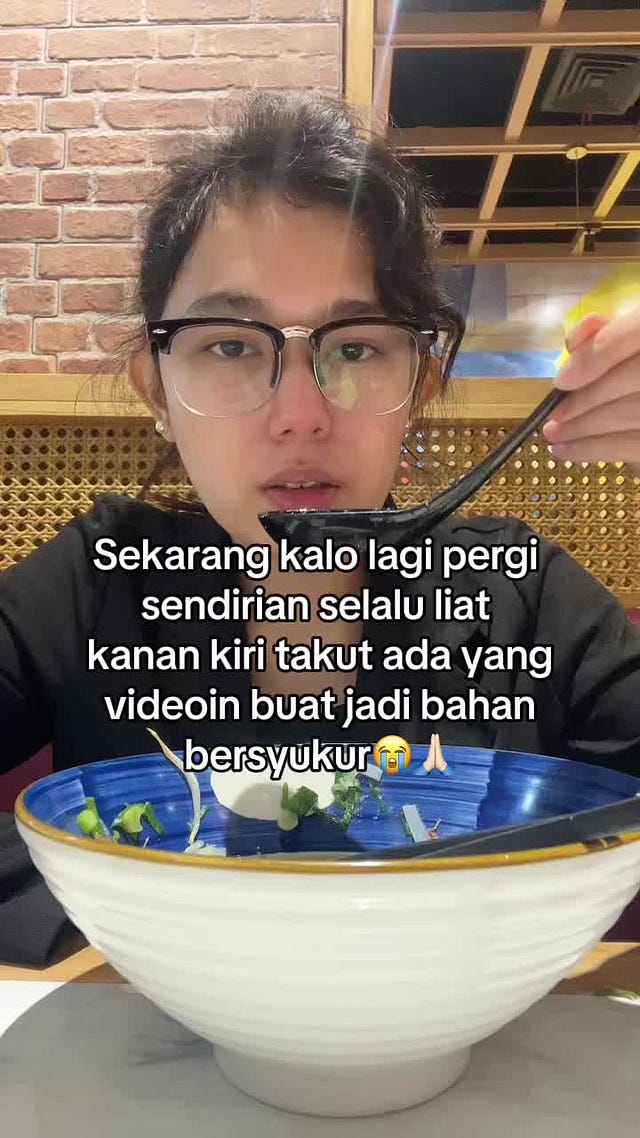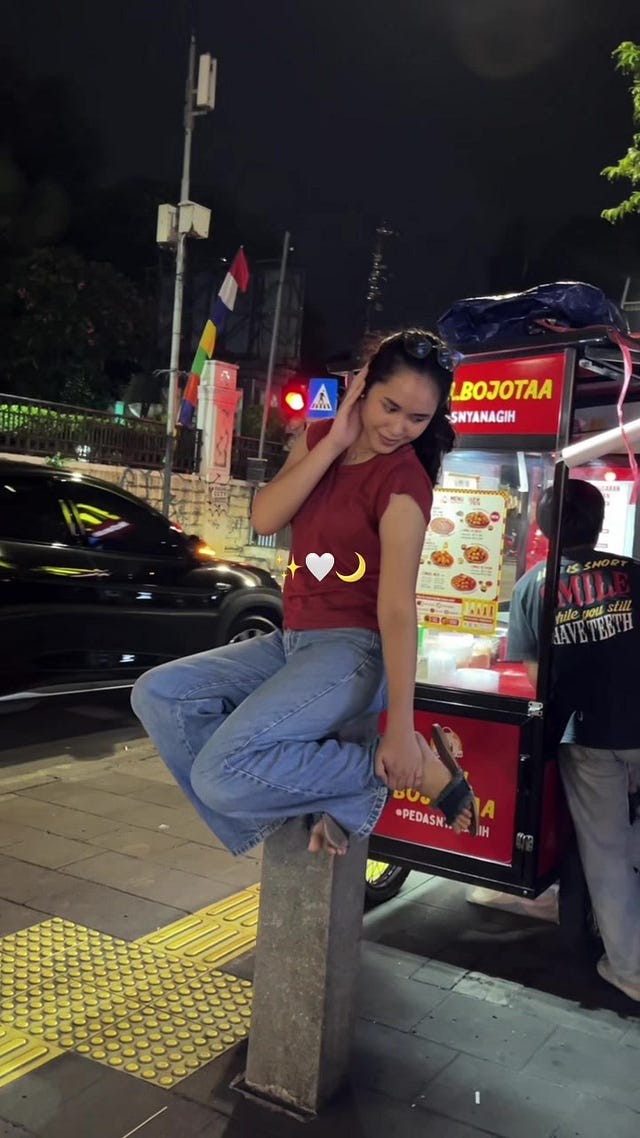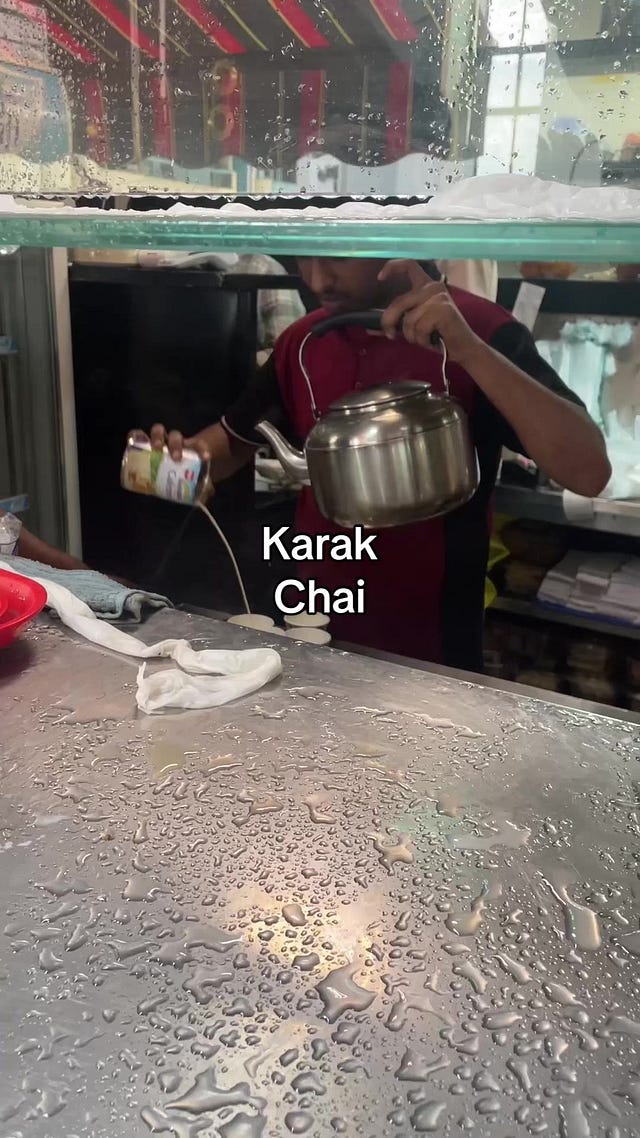Filming in Public: A Creator’s Guide to Doing Better
Let's not be weird about other people's privacy.
Halo and happy Monday! Welcome to Kepayang. My name is Fabi, a writer and initiator of this platform, where I discuss all things food, culture, and sustainability through essays and community activities.
Today, I want to reflect on some thoughts I’ve had as a content creator, especially one who often makes content in public spaces. A few days ago, I came across a post from someone who had been caught in someone else’s video and asked for it to be taken down. The creator eventually did remove it, but not without making it weird: they brushed it off, saying it shouldn’t be a big deal since the person only appeared for a few seconds, and even complained that taking the video down hurt their engagement.
I remember thinking, “That’s fucking weird”. As a responsible creator, we should be aware of how we’re filming in public, including asking for consent and taking accountability when someone wants it to be removed. But the reality is, there’s no clear rulebook or law guiding us on this. And honestly, I’ve made mistakes too. I’ve captured people’s faces without thinking twice.
This letter is for all of us. To reflect on what privacy means today, and how we, especially those of us creating content in public, can do better. Enjoy the read!
Kepayang is free for now, so any engagements mean so much to support the platform’s growth. You can subscribe to get the newsletter sent directly to your email, like, comment, and share if you resonate with what I write.
Alternatively, you can buy me a coffee through my PayPal here: https://paypal.me/chalafabia - or if you’re based in Indonesia, you can send your donation through QRIS here (under the name Tamanan). Any amounts are welcomed and will directly contribute to sustaining this platform to cover expenses related to operations, research, writing, and marketing. ☕️
 Tiktok failed to load.
Tiktok failed to load.Enable 3rd party cookies or use another browser
I was thinking of opening today’s letter with a TikTok video to ease into the topic. But now that I think again, this video has layers, and I might need to explain even more. So here’s how to make sense of it:
The text loosely says: “These days if I go out alone I keep checking left and right – scared someone’s recording me to post like ‘be grateful y’all’” 😭🙏
It refers to an Indonesian trend where people secretly filmed strangers alone in public, like eating, and turned it into emotional content with captions like “be grateful” or “stay strong,” as if being alone meant you’re going through something.
Now the joke is that you can’t even chill by yourself in public without risking becoming someone’s sad, viral inspiration.
That’s a lot for setting a context. But my point is:
These days, filming in public has been so normalised. What exactly are people recording out there?
A few common examples I’ve seen on my TikTok FYP, ones I’m pretty sure aren’t just happening in Indonesia, are below:
Vlogs: Daily life, travel, or “day in my life” content.
Street Interviews: Asking strangers silly or thought-provoking questions.
Dance / Trend Videos: Performing trends in public spaces.
Food Reviews: Trying and reviewing foods in cafes/restaurants.
Edits of Strangers: Secretly filming people and adding captions over them.
 Tiktok failed to load.
Tiktok failed to load.Enable 3rd party cookies or use another browser
While these videos can be harmless or entertaining, they blur the line between public content and personal privacy. And before continuing, let’s first define what privacy even is.
The most basic definition comes from the Cambridge Dictionary, which says privacy is “someone’s right to keep their personal matters and relationships secret”. And if you’re thinking, “What the hell does that mean?”, I got you.
To help us understand it a bit more clearly, let’s dissect what people are asking for when they say they want privacy. Bear with me.
According to Rössler (2005), a professor of ethics, privacy is basically about being able to control who gets access to information about you. This was later expanded by Tunick (2014), who teaches political theory, law, and ethics, that there are essentially two ways you can control privacy: one, having a physical personal space where you can do things without being watched or interrupted; and two, being anonymous and just blending in without anyone recognising you.
In public, personal space is already limited; that’s one layer of privacy gone. Filming strips away the other: our anonymity.
What does it feel like to be filmed in public without consent? And if it happens to you, what can you do about it?
Here’s a story from Bianca (@biancagoenawan), a food content creator in Jakarta, who told me about a time this happened to her. “I was once filmed by another food blogger for their video without permission, and I ended up being the main focus. I was so annoyed”, she said.
She also shared what her boundaries are when it comes to being filmed in public. “(Filmed) from the back is fine, or if it’s clearly accidental, that’s okay too, you can usually tell when it is”. But in this case, she was clearly the main subject of the video, and finding out only after it was already uploaded left her feeling pretty uncomfortable.
At the end, she didn’t message the creator about the video. “I tried reaching out (to the said creator) a few times before about other things, but they never replied. So I figured, what’s the point?”, she said.
Why don’t people want their privacy violated?
Bianca mentioned a really good point, similar to the earlier definition, that we humans like the feeling that we have control over ourselves, and that includes how people perceive us.
When our privacy is violated, there are real risks involved:
Our image can be taken out of context. Turned into a joke, a meme, or used in emotional posts without our consent.
Our safety can be compromised. Being identified without permission can open the door to things like stalking or harassment.
Our mental well-being can take a hit. Okundaye, via The Guardian (2023), shared how someone once filmed him dancing in public. While the video was never uploaded, months afterwards, he still felt anxious, constantly looking over his shoulder whenever he danced.
The above reasons are strong, valid reasons for you not to want to be filmed in public. But remember, you also don’t need to justify it.
In the simplest terms, saying no is enough.
 Tiktok failed to load.
Tiktok failed to load.Enable 3rd party cookies or use another browser
As a content creator myself, I now want to hear from other fellow creators: how should we act when filming in public?
To answer this, I spoke with three food content creators in Jakarta: Bianca (again), Amanda, and Mitha (@nyamnyam.mith). They regularly shoot in cafés, restaurants, and other public spots. Each of them shared how they try to navigate the blurry boundaries between content creation, storytelling, and respecting people’s privacy.
How can creators minimise strangers’ visibility?
Bianca is especially mindful about not showing people’s faces. “I always try to avoid getting people’s faces in frame. If it’s unavoidable, I’ll ask first, like, ‘Hey, is it okay if you end up in the background?’” she said. When filming in busier places, her husband (who often shoots with her) switches on cinematic mode to automatically blur the background. Even when she films at stalls or restaurants, she checks in with the staff. “Usually someone will say, ‘Just don’t show me, yeah?’”, a reminder that even those working in public-facing roles don’t always want to be visible.
Mitha takes a similar approach. “Most of the time, if I’m filming people, it’s just to show the vibe of the place, not to focus on anyone specifically”, she said. She tries to film from behind or from angles where people’s faces aren’t visible, and doesn’t linger too long on one shot.
Amanda acknowledges that being filmed in public can feel uncomfortable for some people, but also points out that there aren’t clear rules around it. “Since there’s no law about it here, technically it’s still fair game”, she said. Even so, she tries to be mindful. “I think filming with good manners matters, like not showing someone’s full face, and definitely not posting if they’re caught in an embarrassing moment”.
Navigating Client’s Demands and Aesthetics
Amanda, who often works with cafés and restaurants, told me it can get even more complicated when dealing with clients’ expectations. “It’s really tricky”, she admitted. “Sometimes clients specifically ask me to capture busy scenes to show that the place is lively, which means filming with lots of people in frame”.
This became especially harder for viral places. “If the place is viral, there’ll be so many people it’s impossible to blur every single face”, Amanda said. “And blurring too much can ruin the look of the whole thing”.
As a viewer and creator, she loves cinematic, atmospheric content. “Showing people’s faces and emotions adds depth and makes it feel more real. Like, it captures people in motion, you know?”, she added. But she also knows it’s not ideal. “Getting consent from everyone one-by-one is honestly just impossible”. In the end, she hasn’t really needed to blur anyone’s face, since her videos mostly focus on food, interior shots, and rarely include people.
When Strangers Speak, Creators Should Listen
Mitha shared that there was one time someone spotted themselves in her video and left a comment, not to complain, but to laugh. “They wrote (to me), ‘That’s us, guys! Lol,’ and tagged all their mates”. She, too, said she hasn’t experienced anyone asking for a takedown. “So far, alhamdulillah (thankfully), no one’s ever complained or asked me to take anything down”, she said.
But if things go wrong, and she were to be asked to take down a video, Mitha said she would handle it with grace. “If someone wasn’t okay with it, I’d say sorry to them first. And if it was a sponsored post, I’d let the brand know and delete the video and repost it without that person in it”, she said. Even though that could hurt engagement, especially with how unpredictable the algorithm is these days, she’d rather own up and fix the mistake. “It’s on us (as creators)”, she said. “Better to deal with it early than let it turn into something bigger”.
Filming in public should balance between what looks good and what feels right.
As content creators, we have the tools and power to shape narratives, but with that comes responsibility. Public spaces may blur the lines of what’s “fair game,” but people’s comfort and consent should never be secondary to aesthetics or engagement.
I’ll be honest, I haven’t always done all of these things either. Like many creators, I’ve learned along the way. These aren’t rules to shame or call anyone out, but rather a reminder. These guidelines are for all of us, including me.
How would you feel if you saw yourself in a stranger’s video, without ever knowing you were filmed?
Other contents that I made recently:
😫 Read why I typically don’t wait in line for food: here.
🌰 Read about why jengkol deserves more love: here.
😱 Read about how Southeast Asians are so brave when cooking: here.
💲 Read about how currency exchange might affect your food price: here.
🌱 Read about what kepayang, the plant, truly is: here.
💥 Read about how bakwan sayur is political: here.
If you like today’s newsletter, please like and share it with your friends! Comment down below your thoughts, and let me know if you have any other topics you want me to discuss. Until then, I’ll see you in two weeks!
Follow me everywhere:
TikTok: @berusahavegan
Kepayang’s Instagram: @readkepayang
Instagram: @menggemaskan
LinkedIn: Chalafabia Haris
Work with me: readkepayang@gmail.com










thank you for writing this—such a reminder. ps: i enjoyed reading the flowcharts